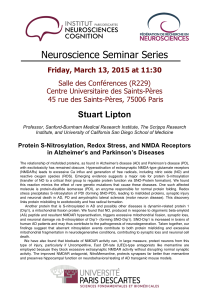Neuroscience Seminar Series,
Friday, March 13, 2015 at 11:30 am
Salle des Conférences (R229), Centre Universitaire des Saints-Pères, 45 rue des Saints-Pères, 75006 Paris
Stuart Lipton, Professor, Sanford-Burnham Medical Research Institute, The Scripps Research Institute, and University of California San Diego School of Medicine
Protein S-Nitrosylation, Redox Stress, and NMDA Receptors in Alzheimer’s and Parkinson’s Diseases
The relationship of misfolded proteins, as found in Alzheimer’s disease (AD) and Parkinson’s disease (PD), withexcitotoxicity has remained obscure. Hyperactivation of extrasynaptic NMDA-type glutamate receptors (NMDARs) leads to excessive Ca influx and generation of free radicals, including nitric oxide (NO) and reactive oxygen species (ROS). Emerging evidence suggests a major role for protein S-nitrosylation (transfer of NO to a critical thiol group to regulate protein function via SNO-Protein formation). We found this reaction mimics the effect of rare genetic mutations that cause these diseases. One such affected molecule is protein-disulfide isomerase (PDI), an enzyme responsible for normal protein folding. Redox stress precipitates S-nitrosylation of PDI (forming SNO-PDI), leading to misfolded proteins, synaptic injury and neuronal death in AD, PD and amyotrophic lateral sclerosis (motor neuron disease). This discovery links protein misfolding to excitotoxicity and free radical formation.
Another protein that is S-nitrosylated in AD and possibly other diseases is dynamin-related protein 1 (Drp1), a mitochondrial fission protein. We found that NO, produced in response to oligomeric beta-amyloid (Aß) peptide and resultant NMDAR hyperactivation, triggers excessive mitochondrial fission, synaptic loss, and neuronal damage via S-nitrosylation of Drp1- (forming SNO-Drp1). SNO-Drp1 is increased in brains of human AD patients and may thus contribute to the pathogenesis of neurodegeneration. Taken together, our findings suggest that aberrant nitrosylation events contribute to both protein misfolding and excessive mitochondrial fragmentation in neurodegenerative conditions, contributing to synaptic loss and neuronal cell death.
We have also found that blockade of NMDAR activity can, in large measure, protect neurons from this type of injury, particularly if Uncompetitive, Fast Off-rate (UFO)-type antagonists like memantine are employed because they block excessive extrasynaptic NMDAR activity without disrupting normal synaptic activity. The improved NMDAR antagonist, NitroMemantine, protects synapses far better than memantine and preserves hippocampal function on neurobehavioral testing of AD transgenic mouse models.
